Translate this page into:
The phytochemical screening and antiangiogenic activity of audthan al himar (Moricandia sinaica Boiss.) extracts in zebrafish embryos and human umbilical vein endothelial cells
⁎Corresponding author. fmuhammad@ksu.edu.sa (Muhammad Farooq)
-
Received: ,
Accepted: ,
This article was originally published by Elsevier and was migrated to Scientific Scholar after the change of Publisher.
Peer review under responsibility of King Saud University.
Abstract
Natural antiangiogenic products interact with multiple molecular angiogenic pathways and possesses comparably less toxicities then chemically synthesized anti-angiogenic compounds. There is a need to screen varieties of medicinal plants to identify more sources of antiangiogenic compounds, as anticancer drugs with less side effects. This study was designed to explore the antiangiogenic property and cytotoxicity of Moricandia sinaica (Boiss.) in zebrafish embryos, as well as its anti-migratory potential in human umbilical vein endothelial cells (HUVECs). Gas chromatography coupled with mass spectrophotometry was performed in order to identify bioactive molecules present in the stem and leaves part of Moricandia sinaica.
The methanol extract of the stem and leaves inhibited the formation of the inter-segmental, sub-intestinal vein, and dorsal longitudinal anastomotic veins formation in zebrafish embryos in a dose- dependent manner. It did not show cytotoxicity at lower concentration in HUVECs; however, it significantly (p < 0.001) obstructed HUVEC migration at sub-lethal concentrations after 24 and 48 h of treatment. More than 40 phytochemicals were identified from the extract using GC–MS.
Our study demonstrates that leaves and stem extract of Moricandia sinaica, exhibits a strong antiangiogenic activity and slight developmental toxicity in zebrafish embryos, and no cytotoxicity in HUVECs. The crude extract warrants further research to elucidate the anticancer potential of M. sinaica.
Keywords
Moricandia sinaica
Cytotoxicity
Angiogenesis
Human umbilical vein endothelial cells (HUVEC)
Protein target prediction
1 Introduction
Herbs or medicinal plants serve as a source of biologically active molecules and have been used as therapeutic remedies in folk medicines for centuries (Atanasov et al., 2015). The herbal components are applied to treat diverse levels of human diseases, ranging from common cold to the complex lethal diseases, such as cancer in human. The significance of natural products can be judged by the fact that the market for such products, presumably will reach to almost US$115 billion in 2020 (Bob, 2017).
Normal tissue growth and regeneration benefits by angiogenesis. Angiogenesis is an important biological process involved in blood vessel formation. Its deficiency, as well as excess, can lead to several diseases like ischemic tissue injury, cardiac failure, cancer, diabetic retinopathy, and rheumatoid arthritis (Bisht et al., 2010). The therapeutic intervention using angiogenic inhibitors has shown promising results in solid tumors (Miletic et al., 2009). Recently, several natural products have been successfully applied in preclinical trials to target angiogenesis (Fu et al., 2015; Shanmugam et al., 2017). The advantage of natural antiangiogenic products is that they are more effective due to interactions with multiple angiogenic and apoptotic pathways and possessing less side effects, as compared to chemically synthesized angiogenic molecules which (Yehya et al., 2017).
Target-oriented biological screening of medicinal plants in suitable animal models is required at most. The availability of various transgenic lines in zebrafish has revolutionized the biological and high-throughput screenings due to the comparatively smaller size and transparency of embryos (Parng et al., 2002). A transgenic line Tg (fli1:EGFP) is characterized with the integration of a Friend leukemia integration 1 transcription factor (FLI1) together with enhanced green fluorescent protein (EGFP), resulting in ubiquitous EGFP expression in all the blood vessels of the embryo. The time lapse imaging of developing vasculature in these transgenic embryos has revealed sprouting of inter-segmental blood vessels (ISV), sub intestinal vein (SIV), and dorsal longitudinal anastomotic blood vessel (DLAV) from already existing vasculature (Lawson and Weinstein, 2002). Therefore, in zebrafish embryos, ISV, SIV, and DLAV are being considered angiogenic blood vessels. The zebrafish transgenic line Tg (fli1:EGFP) is routinely used as drug screening animal model in order to assess the antiangiogenic activity of chemically-synthesized small molecules or natural products (Tian et al., 2017; Zhang et al., 2018).
The genus Moricandia (Brassicaceae) includes eight species. Some species from this genus are used as traditional medicine. One species from this genus (Moricandia sinaica) is indigenous to Saudi Arabia, known locally as audthan al himar (due to typical shape of leaves resembling donkey’s ear (Fig. 1). Moricandia sinaica (Boiss.) is an annual herb, which is distributed throughout Saudi Arabia, having medicinal application in folk medicine (Arif et al., 2010). The biological activities, phytochemical contents, and bio-active compounds of this plant are largely not known. Taking into account, the medical value, and pharmacological properties of the other species in this family, the Moricandia sinaica (Boiss.) was explored by extracting the crude extract from the roots, stem, leaves, and shoots and were tested for potential antiangiogenic activity in zebrafish embryos.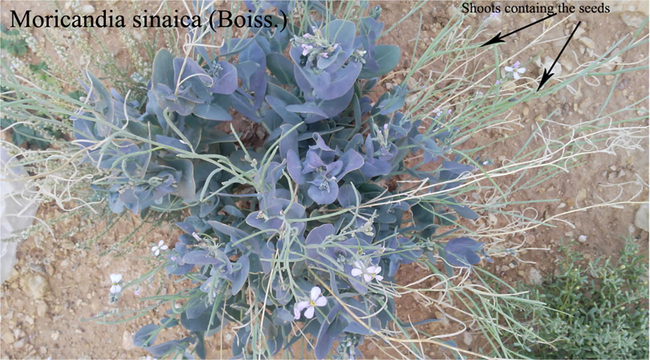
Aerial view of plant Moricandia sinaica (Boiss.).
The antiangiogenic property of M. sinaica was studied in zebrafish embryos and in human umbilical vein endothelial cells (HUVEC) in vitro. Cell proliferation assay using 3-(4,5-dimethylthiazol-2-yl)-2,5-diphenyltetrazolium bromide (MTT) was performed to determine the cytotoxicity in HUVEC. Gas chromatography spectrophotometry (GC–MS) analysis was conducted to identify the biologically active molecules present in crude extract of M. sinaica.
2 Material and methods
2.1 Collection of plant
The plants were collected in flowering season from the outskirts of Riyadh district, Kingdom of Saudi Arabia. Jacob Thomas Pandalayil, Department of Botany and Microbiology, College of Science, King Saud University has identified the plant. The voucher sample (MFQKSU-063/19) was submitted in King Saud University Herbarium.
2.2 Preparation of crude extract
The plants were washed thoroughly with distilled water to remove dirt and dust. The plants were cut into aerial parts and roots, and were dried under shade for several days. Dried roots, stem, leaves and shoots were grounded to powder. The crude extraction of dried parts of M. sinaica was obtained by adding the powder (100 g) in a soxhlet apparatus. Extraction was done in solvents of variable polarities, i.e. n-hexane (n-Hex), chloroform (CHCl3), ethyl acetate (C4H8O2) and methanol.
2.3 Cytotoxicity testing in human umbilical vein endothelial cell line
To determine the cytotoxic of different plant parts of M. sinaica on endothelial cells, human umbilical vein endothelial cells were used and cytotoxicity was analyzed by MTT cell proliferation assay. Human umbilical vein endothelial cells (HUVEC) were used to assess the cytotoxicity by MTT cell proliferation assay. Briefly, 1 × 105 normal cells were plated in 24-well tissue culture plates. After 24 h of incubation at 37 °C in 5% CO2, the cells were treated with various concentrations of extracts for 48 h. At the end of treatment period, 100 µL MTT (5 mg/mL) was added to each well, and incubated for 4 h at 37 °C in 5% CO2. One mL of acidified isopropanol (0.01 N HCL) was added to dissolve the formazan crystals by shaking on orbital shaker for 15 min at 25 °C. The absorbance at 490 nm was detected using microplate reader (BioTek, USA).
2.4 Cell migration assay of HUVECs in vitro
The anti-migratory effect of the M. sinaica methanol leaf extract was assayed using in vitro cell migration on HUVECs. Briefly, 1 × 105 cells/mL were seeded in 6-well plates for 24 h. Cells were then washed with PBS and sterile 200 μL tip was used to make a scratch. The cells were treated with 100 μg/mL of extract and cell migration was observed at 0, 24, and 48 h). The images were captured by inverted microscope (Leica, Germany), equipped with MC-170 HD digital camera.
2.5 Evaluation of anti-angiogenic activity in zebrafish embryos
2.5.1 Animals
Zebrafish transgenic line Tg (fli1:EGFP) was purchased at the zebrafish international resource center (ZIRC, university of Oregon, Oregon USA). The fish are maintained in animal facility at Bioproducts research chair, department of zoology, College of Science, King Saud University Saudi Arabia.) The zebrafish embryos used in this study were less than 5 days post fertilization (dpf), and hence are exempted to take the approval from the institutional committee ethical for the user and care of laboratory animals as stated by (Strahle et al., 2012).
2.5.2 Embryo treatment
The embryos were obtained by pairwise mating of adult fish. The healthy and fertilized eggs were washed with distilled water, and 30 embryos were put in single sterile glass petri dishes of size 60 × 15 mm (NORMAX cat # 505854, Portugal). The serial dilution (10–700 µg/ml) of each crude extract was prepared in 5 ml of embryo medium (distilled water supplemented with 0.04% sea salt and 0.001% methylene blue) and added to each petri dish. The embryos were exposed to the extracts for three days. The extracts were replaced daily with freshly prepared embryo water containing the desired dilution of the extract.
The antiangiogenic potential of the plant was calculated by observing the effect of plants on angiogenesis blood vessels formation in live transgenic zebrafish embryos. The number of angiogenic blood vessels in untreated and treated embryos were counted at two developmental stages one at 48hpf and second at 72hpf. Five to eight embryos were used for each calculation. In order to calculate the blood vessels, the images of the control and treated embryos were taken using fluorescent microscope, and number of blood vessels were calculated using the image J software.
2.6 Gas chromatography-mass spectroscopy
Elmer Clarus 600 gas chromatograph which was linked to a mass spectrometer (Turbomass, PerkinElmer, Inc., Waltham, MA, USA) was used to perform the gas chromatography-mass spectroscopy. The compounds were identified by comparing the spectra with compound libraries at National Institute of Standard and Technology and WILEY.
2.7 Statistics
The IC50 values in case of cytotoxicity and LC50 values for zebrafish toxicity were calculated by probit analysis and also free available online program (http://www.ic50.tk/).
2.8 Microscopy
The image were snapped using Zeiss inverted microscope “Zeiss Observer D1 AX10 using ZEN software provided by Zeiss (GermanY).
3 Results
3.1 The crude extracts yield in solvents of various polarities
The yield of various crude extracts from roots, stem, leaves, and shoots of M. sinaica shown in Fig. 2. Among all the solvents, the methanol crude extracts had maximum yield from all the parts of the plant. The highest yield of methanol crude extract was obtained from the stem part (17.5%), followed by shoot (11.5%), and leaves (11.5%). The other solvents produced variable patterns of yield as presented in Fig. 2.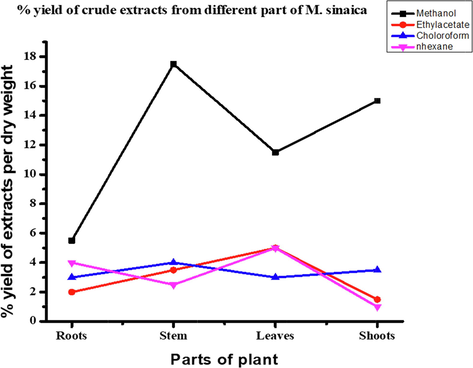
The graphical representation of the yield of different extract prepared from roots, stem, leaves, and shoots.
3.2 Evaluation of in vivo developmental toxicity of M. sinaica in zebrafish embryos
The crude extracts prepared from the roots, stem, leaves, and shoots did not produce severe level of developmental toxicity in treated zebrafish embryos. As shown in Fig. 3, the embryonic development of embryos that were treated with crude extracts was not affected, and the developmental and phenotype of the treated embryos was almost similar to control embryos at 72 h post fertilization (hpf).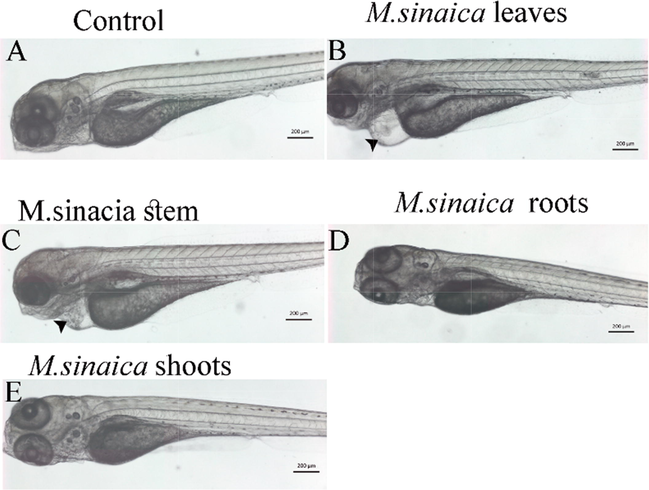
Developmental toxicity of crude extract of M. sinaica parts in zebrafish embryos. The representative images of 72 hpf wild type zebrafish embryos Control (A) and treated with crude extract of leaves (B), stem (C), roots (D), and shoots (E) of M. sinaica. It is evident, that the treated embryos did not exhibit severe malformation except a mild cardiac edema by the leaves and stem extracts which could be due to absence of blood vessels.
3.3 The crude extract of leaves and stem of M. sinaica inhibited angiogenic blood vessels formation in zebrafish embryos on dose-dependent manner
The effective antiangiogenic concentration was determined experimentally by treating the zebrafish Tg (fli1:EGFP) embryos with serial dilution of each of the extract, and an effective antiangiogenic dose was a concentration at which significant level of inhibition of angoigenic blood vessels was observed with minimum level of toxicities in exposed embryos. As shown in Fig. 4, the roots and shoots of M. sinaica were completely inactive and did not altered the formation of angiogenic blood vessels in treated embryos. The dose–response effect has shown that at 40 µg/ml, methanol crude extract of leaves inhibited ≥70% of ISV, DLAV and 100% of SIV, while the effective antiangiogenic concentration for methanol crude stem extract was 50.31 µg/ml of M. sinaica in zebrafish embryos.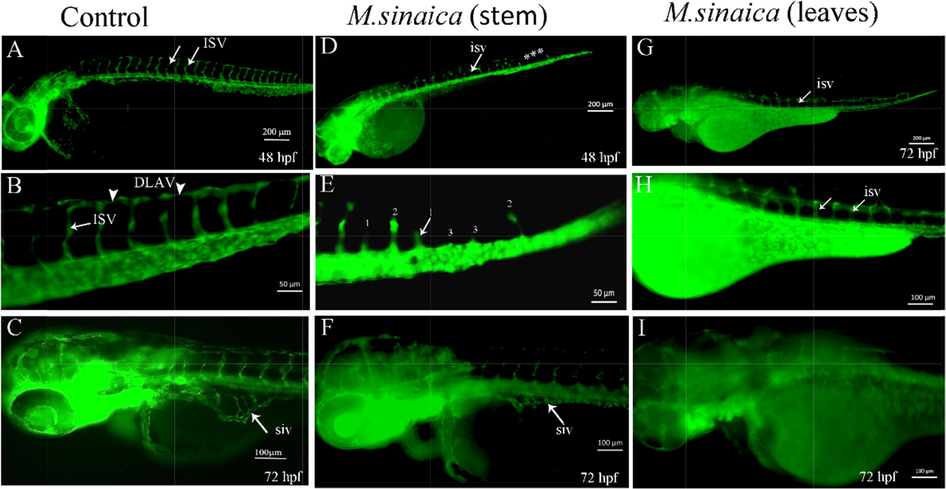
The crude extract of leaves and stem of M. sinaica inhibited angiogenic blood vessels formation in zebrafish embryos on dose-dependent manner.
The representative images of Tg (fli:EGFP) embryos at 72hpf showing the effect of extract of M. sinaica treatment on angiogenic blood vessels formation. A & B) The ISV and DLAVE of control embryos are intact and developed normally. The SIV 8–10 blood vessels on yolk region of control embryos is shown in C. The Tg (fli1: EGFP) embryos at 48hpf; treated with crude extract of stem are shown in D and E. The ISV are completely absent at the posterior trunk region shown by asterisk. The posterior trunk region of tread embryos has been shown at higher magnification in E. The severity of the abnormalities in angiogenesis blood vessels in treated embryos has been represented by different number: 1) ISV sprouted from dorsal aorta but did not grow and connect to DLAV. 2) ISV sprouted from dorsal aorta and has grown to middle of trunk region. 3) Complete absence of ISV. The Tg (fli:EGFP) embryos which were treated with leaves extract had severe malformation in angiogenic blood vessels at 48hpf (G&H). The ISVs in 100% of treated embryos were not intact and most of them hardly reached to middle trunk, and DLAV is completely absent.
The image F shows the SIV of transgenic zebrafish embryos treated with stem extract. The SIV formed in treated embryos however, did not grow into basket like structure that could be due to inhibition of migration of endothelial cells. The yolk region of the transgenic zebrafish embryos treated with leaves extract is shown in I), The SIV in treated embryos are completely absent.
3.4 The crude extract of leaves and stem of M. sinaica showed weaker level of cytotoxicity in HUVECs
MTT cell proliferation assay has showed that M. sinaica exhibited a weaker level of cytotoxicity in HUVECs. The crude extracts prepared from roots, leaves, and flowers were completely inactive even at maximum concentration (700 µg/ml). The crude methanol extract of leaves showed weak level of cytotoxicity with IC50 values of 246.30 µg/ml in HUVECs and crude extract of stem had IC50 values of 348.78 µg/ml.
3.5 The methanol leaves extract perturbed the migration of HUVECs
Treatment of HUVECs with crude methanol extract of leaves significantly inhibited cellular migration of HUVECs in a time-dependent manner. As shown in Fig. 5, the control untreated HUVECs almost covered the scratched area after 48 h, whereas the migratory ability of HUVECs treated with 100 µg/ml of the leaves extract of M. sinaica was significantly reduced (p < 0.01 and p < 0.001, 24 h and 48 h, respectively).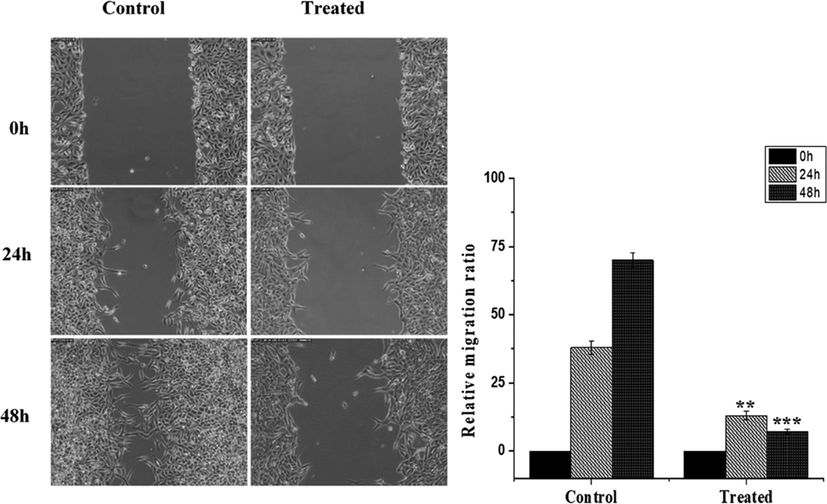
The methanol leaves extract perturbed the migration of HUVECs.
The migration assay showing the control and crude leaves extract treated HUVECs (A) and graphical representation of distance covered (B). The pictures at 0 h are soon after scratch is made. The control HUVEC cells migrated and covered around 38% of scratched area after 24 h and around 75% of scratched area after 48 h, whereas the treated cells had covered around 13% of scratched area after 24 h and the migration potential of treated cells remained same after 48 h of treatment.
3.6 Evaluation of biologically active molecules containing in the stem and leaves of M. sinaica
As the methanol crude extract of leaves and methanol extracts of stem have shown antiangiogenic activity in zebrafish embryos, we, next, sought to identify the molecules, which are represented in both types of the extracts. In order to find out the diversity of bioactive molecules presented in both type of extracts, GC–MS analysis was performed. Twenty-one compounds were identified in methanol crude extract of leaves. The identified compounds with chemical formula, molecular weight, retention time, and percentage of the covered areas are summarized in Tables 1 and 2, while the GC–MS chromatogram of leaves and stem are shown in Figs. 6 and 7 respectively.
Compound name
Chemical formula
MW (g/mol)
RT
Area %
3-Pentenenitrile
C5H7N
81.12
4.00
28.950
L-Proline
C5H9NO2
115.13
7.45
4.170
[1,3]Diazepane-2,4-dione
C5H8N2O2
128.13
8.06
3.890
4,5-Epithiovaleronitrile
C5H7NS
113.18
8.48
1.150
2,3-Dihydro-3,5-dihydroxy-6-methyl
C6H8O4
144.12
8.79
3.310
3,7,9-trimethyl-6-dodecanone
C15H24
204.35
8.90
0.580
1-Undecanol
C11H24O
172.31
11.34
0.410
2-Pyrrolidinone
C4H7NO
85.1
11.53
5.100
D-Allose
C6H12O6
180.16
13.69
15.470
3-Hexadecene
C16H32
224.42
13.87
0.320
D-Mannoheptulose
C7H14O7
210.18
14.31
1.650
8-Azaxanthine
C4H3N5O2
153.1
15.67
2.960
1-Heptadecene
C17H34
238.5
15.74
0.260
Neophytadiene
C20H38
278.5
16.10
0.760
7-Methylbicyclo[4.1.0]heptane
C8H14
110.2
16.28
0.290
3,7,11,15-tetramethyl-2-hexadecene
C20H40
280.5
16.43
0.580
5-Methyl-2-(1-methyl)-cyclohexanol
C10H18O
154.25
16.59
0.390
Methyl ester of heptadecanoic acid
C18H36
284.47
16.78
0.620
Hexadecanoic acid
C16H29O2
256.43
17.15
22.670
3,7,11,15-tetramethyl-2-hexadecen-1-ol
C20H40O
296.5
18.06
0.580
9-Octadecenoic acid
C18H34O2
282.5
18.33
4.090
Compound name
Chemical formula
MW (g/mol)
RT
Area %
3-Pentenenitrile
C5H7N
81.12
4.01
54.790
Piperidine
C5H11N
85.15
4.88
1.800
1,2-Cyclopentanediol
C5H10O2
102.13
5.30
1.450
Methyl beta-D-galactopyranoside
C7H14O6
194.18
6.88
1.190
2,3-Dihydro-3,5-dihydroxy-6-methyl-4 h-pyran-4-one
C6H8O4
144.12
8.81
3.660
1-Undecanol
C11H24O
172.31
11.36
0.990
L-Proline
C5H9NO2
115.13
11.54
11.200
D-Allose
C6H12O6
180.16
13.63
6.330
5-Eicosene
C20H40
280.5
13.88
1.650
1-Tetradecanol
C14H30O
214.39
15.75
1.220
9-Octadecenoic acid
C18H34O2
282.5
17.26
2.760
Dotriacontane
C32H66
450.9
19.28
7.670

GC–MS chromatogram of the leaves extract of M. sinaic.
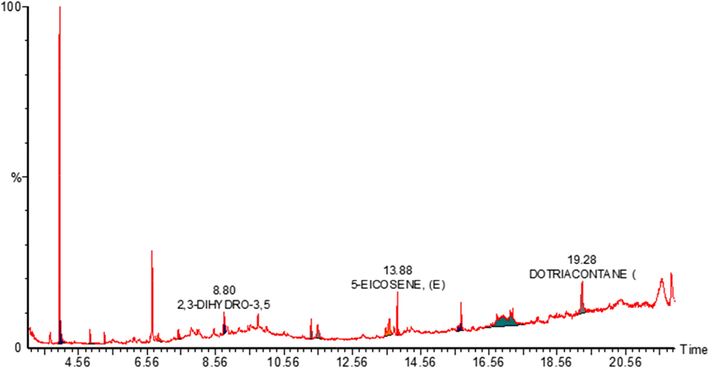
GC–MS chromatogram of the stem extract of M. sinaic.
The compound “3-pentenenitrile” was identified as major compound in the methanol extract of leaves of M. sinaica covering 30% of the chromatogram. The second major compound was hexadecanoic acid in the methanol extract of leaves, which composes around 23%, and third major compound was D-allose (16%).
4 Discussion
Many of currently used pharmacological agents are either the secondary metabolites or pure compounds, derived from medicinal plants. The majority of Saudi Arab peninsula is composed of arid land. The vegetation consists of mostly xerophytic plants and herbs. Moreover, the flora of Saudi Arabia is very diverse, representing a mixture of indigenous species and flora from Asian, African, and Mediterranean regions (Rahman et al., 2004). However, most of the local medicinal plant species have not been scientifically studied, and biologically active phytochemicals are not known.
The genus Moricandia (Brassicaceae family) includes eight species. Some species from this genus are used as traditional medicine. Leaves and stems of M. arvensis (L.) are used in the treatment of syphilis and scorbut (Skandrani et al., 2017). The lipase inhibitory activity from the crude extract of aerial parts of M. arvensis (L.) has been shown by (Marrelli et al., 2018). The leaf and root extracts of M. arvensis have been shown to elicit a protection effect against H2O2-induced genotoxicity in human lymphoblast cell line and several phytochemicals have been identified from the aerial parts of M. arvensis (Bennett et al., 2004; Tatsuzawa et al., 2015).
M. sinaica is a perennial herb however; the phytochemical contents and biological properties of this plant have not been investigated prior to this study. The methanol extract of the stem and leaves inhibited the formation and growth of the inter-segmental, sub-intestinal vein and dorsal longitudinal anastomotic veins in a dose-dependent manner. The in vitro endothelial cell migration assay performed in HUVECs has revealed that methanol extract of the leaves interfered with the migration of HUVECs. The MTT cell proliferation assay has shown that the methanol extract of leaves of M. sinaica inhibited the cell proliferation of HUVECs with IC50 values more than 170 µg/ml, whereas significant reduction in migration of HUVEC was observed at concentration of 100 µg/ml. Hence, it is quite evident from a result that the antiangiogenic activity of leaves extract of M. sinaica was due to inhibition in the migration of endothelial cells rather than a toxicity. The migration of endothelial cells is a key step for the formation of angiogenic blood vessels (Lamalice et al., 2007).
The GC–MS data has demonstrated that the extracts of leaves and stem shared major biomolecules. The 3-pentenenitrile was present with ratio of 29% in the extract of leaves, while it was found to be 54% in the extract of stem. The D-allose constitutes 6.33% of the extract of stem and 15% of leaves extract. The leaves also contained 23% hexadecanoic acid, which was not detected in the extract of stem and, therefore, could be the reason for the more potent angiogenic activity of leaves extract of M. sinaica as compared to stem extract. Hexadecanoic acid (palmitic acid) has been shown to inhibit angiogenesis via regulating the Hippo–Yes-associated protein (YAP) pathway (Laouirem et al., 2019).
These results clearly demonstrate that the inhibition of angiogenesis blood vessels in zebrafish embryos and inhibitory effect on the migration of HUVECs in vitro leaves extract of M. sinaica could be due to the antagonist activity of 3-pentenenitrile, D-allose, and hexadecanoic acid on the regulatory proteins of angiogenesis.
5 Conclusion
The xerophytic plants of Saudi Arabia as M. sinaica possess valuable phytochemicals, which have the potential to be developed as an effective and safe antiangiogenic drugs to be used as a single therapy or in combination with other chemotherapy agents to treat cancer patients and cure the complications in diabetic retinopathy.
Funding
Funding was provided by the National Plan for Science, Technology, and Innovation (MAARIFAH), King Abdulaziz City for Science and Technology, Kingdom of Saudi Arabia through Award number 11-BIO1871-02.
Acknowledgments
The authors would like to acknowledge the support of the National Plan for Science, Technology, and Innovation (MAARIFAH), King Abdulaziz City for Science and Technology, Kingdom of Saudi Arabia through Award number 11-BIO1871-02. This support is highly appreciated and acknowledged.
Declaration of Competing Interest
The authors declare that they have no known competing financial interests or personal relationships that could have appeared to influence the work reported in this paper.
References
- Application of RAPD for molecular characterization of plant species of medicinal value from an arid environment. Genet. Mol. Res.. 2010;9(4):2191-2198.
- [Google Scholar]
- Discovery and resupply of pharmacologically active plant-derived natural products: A review. Biotechnol. Adv.. 2015;33(8):1582-1614.
- [Google Scholar]
- Screening crucifer seeds as sources of specific intact glucosinolates using ion-pair high-performance liquid chromatography negative ion electrospray mass spectrometry. J. Agric. Food Chem.. 2004;52(3):428-438.
- [Google Scholar]
- Angiogenesis: Future of pharmacological modulation. Indian J. Pharmacol.. 2010;42(1):2-8.
- [Google Scholar]
- Bob, Allkin 2017. State of the World's Plants 2017: Royal Botanic Gardens, Kew London UK.
- Curcumin inhibits angiogenesis and improves defective hematopoiesis induced by tumor-derived VEGF in tumor model through modulating VEGF-VEGFR2 signaling pathway. Oncotarget. 2015;6(23):19469-19482.
- [Google Scholar]
- Endothelial fatty liver binding protein 4: a new targetable mediator in hepatocellular carcinoma related to metabolic syndrome. Oncogene. 2019;38(16):3033-3046.
- [Google Scholar]
- In vivo imaging of embryonic vascular development using transgenic zebrafish. Dev. Biol.. 2002;248(2):307-318.
- [Google Scholar]
- Phytochemical and biological profile of Moricandia arvensis (L.) DC.: an inhibitor of pancreatic lipase. Molecules. 2018;23(11)
- [Google Scholar]
- Anti-VEGF therapies for malignant glioma: treatment effects and escape mechanisms. Expert Opin. Ther. Tar. 2009;13(4):455-468.
- [Google Scholar]
- Zebrafish: a preclinical model for drug screening. Assay Drug Dev. Technol.. 2002;1(1 Pt 1):41-48.
- [Google Scholar]
- Medicinal plant diversity in the flora of Saudi Arabia 1: a report on seven plant families. Fitoterapia. 2004;75(2):149-161.
- [Google Scholar]
- Potential role of natural compounds as anti-angiogenic agents in cancer. Curr. Vasc. Pharmacol.. 2017;15(6):503-519.
- [Google Scholar]
- Antioxidant, antimutagenic, tanning and calpain induction activities of methanolic extract of tunisian plant (Moricandia Arvensis) Iran J. Pharm. Res. 2017:16119-16134.
- [Google Scholar]
- Zebrafish embryos as an alternative to animal experiments–a commentary on the definition of the onset of protected life stages in animal welfare regulations. Reprod. Toxicol.. 2012;33(2):128-132.
- [Google Scholar]
- Acylated cyanidin 3-sophoroside-5-glucoside in purple-violet flowers of Moricandia arvensis (Brassicaceae) Nat. Prod. Commun.. 2015;10(3):457-459.
- [Google Scholar]
- Yehya, A. H. S., M. Asif, Y. J. Tan, S. Sasidharan, A. M. S. A. Majid and C. E. Oon 2017. Broad spectrum targeting of tumor vasculature by medicinal plants: An updated review. J Herb Med 91-13.
- Monitoring antiangiogenesis of bevacizumab in zebrafish. Drug Des. Dev. Ther.. 2018;122423–2430
- [Google Scholar]







